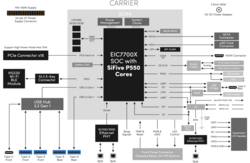news
SiFive and Red Hat Collaborate to Bring RHEL 10 to RISC-V Development
Quoting: SiFive and Red Hat Collaborate to Bring RHEL 10 to RISC-V Development —
Both SiFive and Red Hat participate in the RISC-V Software Ecosystem Project, which aims to accelerate the maturity of open-source software on RISC-V. The availability of RHEL 10 for the HiFive Premier P550 is a significant milestone for commercial-grade RISC-V adoption in data centers.
SiFive notes that its high-performance RISC-V hardware is already being used for AI and machine learning workloads. With RHEL 10 support, developers now have a familiar enterprise-grade toolchain for building full-stack solutions on open hardware.
FOSS Force:
-
Rocky Linux 10 Will Run on RISC-V - FOSS Force
It doesn’t seem that long ago that the folks at SiFive, RISC-V International, or others I met at a RISC-V Summit predicted it would be several years before the open source instruction set, RISC-V, would power desktops, laptops, or servers. Back then, open source silicon supporters were elated just because companies like Western Digital were ready to use the ISA to build accelerators and the like.
Those days are gone. At least three companies are now offering laptops with a RISC-V option. There are quite a few RISC-V-based single board computers available, and the ISA is even starting to make tentative inroads into servers and data center space. Also, those who get their hands on a RISC-V laptop or SBC won’t have trouble finding something to run on it, since at least six major Linux distributions have been ported to run on RISC-V silicon.
Linuxiac:
-
Rocky Linux 10 Adds Official RISC-V Support
The Rocky Linux project has announced an expansion of its hardware support in the upcoming Rocky Linux 10, confirming official support for the emerging RISC-V open-source architecture.
This move is due to the dedicated collaboration between the Fedora RISC-V community and Rocky Linux’s Alternative Architectures Special Interest Group (AltArch SIG).
Expected to roll out soon (RHEL 10 is already available), Rocky 10 will include riscv64gc builds, aligning closely with Fedora’s supported platforms.
Another One From FOSS Force:
-
RISC-V's Big Week Includes RHEL, CentOS Stream, and Rocky Linux - FOSS Force
Yesterday, when I wrote about Rocky Linux’s upcoming support for RISC-V Rock Linux 10, I missed a couple of even bigger stories that surfaced this week about RISC-V and Red Hat. It appears that earlier this week at Red Hat Summit, alongside the unveiling of RHEL 10, Red Hat announced a collaboration with RISC-V-focused SiFive that’s resulted in a RHEL 10 Developer Preview for RISC-V.
That’s some serious big-time cred for RISC-V. Especially if you couple that with the news that CentOS Stream, Red Hat’s other enterprise-focused Linux distro, is also touting RISC-V support in the form of a source code release of CentOS Stream 10 with RISC-V support.
On Tuesday, in a short post on Red Hat’s blog, the company’s Emerging Technology product manager Steve Wanless said that the CentOS version is being released within the CentOS ISA special interest group and suggests watching the CentOS blog for more information.
It's FOSS News:
-
Red Hat Enterprise Linux and Rocky Linux Embrace RISC-V
Designed to be simple, flexible, and non-proprietary, RISC-V is an open standard instruction set architecture (ISA) that defines the set of instructions a processor can execute.
Developed and maintained by RISC-V International, a Swiss-based non-profit, RISC-V's open architecture allows anyone to design, implement, and fabricate custom CPUs without worries of licensing fees.
We were already seeing a steady rise in its adoption, and a recent slew of announcements has only accelerated RISC-V's upward trend.
Notebook Check:
-
Red Hat Enterprise Linux 10.0 now available with next-gen security features
Red Hat Enterprise Linux (RHEL) 10.0 has been introduced at the Red Hat Summit 2025. Based on the Linux 6.12 LTS kernel, this milestone release comes with Wayland instead of the X11 desktop environment. The Cockpit web console also received a revamp and now delivers improved file management capabilities, including direct uploads from the browser.
According to the official press release, this release is "the first enterprise Linux distribution to integrate National Institute of Standards and Technology (NIST) standards for post-quantum cryptography" thanks to the inclusion of quantum-resistant algorithms and post-quantum signature schemes.
Developers and system admins receive RHEL Lightspeed, an AI-powered assistant designed to ease their work. Issues such as SSH failures can now be troubleshooted with AI-driven guidance. Desktop apps get Flatpak support, while non-modular packages align RHEL 10 with CentOS Stream 10.

